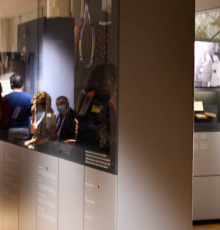Categories
Closing weekend of the "Fake for Real" temporary exhibition

Come celebrate with us the last days of our temporary exhibition “Fake (f)or Real, a history of forgery and falsification”!
Follow our experts in the galleries to learn more about forgeries related to war, art, fashion and relics of saints. Take part in an artistic workshop with the collective Apparatus 22: rearrange quotes and pieces of popular wisdom to create your own truths and slogans on a banner, unveiling a new world of poetic possibilities. Have your conceptions about fakes shattered by filling in an intriguing questionnaire and see that in the end, the process might matter even more than the results. Or you can opt for striking a pose in a unique photo studio created by the collective Oiseaux sans tête and find yourself on the front page of a very real fake magazine.
Programme:
12:00 - 18:00 - Drop-in activities: creative workshop and photo studio
14:00 - 16:00 - Expert talks in the galleries
Sophie Pitman
Sophie Pitman is a Leverhulme early career fellow at UCL where she explores the history of early modern clothing and its relationship to the weather and environment. Pitman gained her PhD in History from Cambridge University in 2017, and formerly held postdoctoral research fellowships on the Making and Knowing Project at Columbia University and the ERC-funded Refashioning the Renaissance Project at Aalto University. She has published on sumptuary law, issues of luxury and the everyday, and reconstruction as a methodology and recently curated the exhibition 'Reconstructing Everyday Fashion, 1550-1650' at the Dipoli Gallery in Helsinki, Finland. She combines traditional historical source analysis of texts and images with close study of surviving objects and hands-on experimental methods.
Geert Sels
Geert Sels (1965) is a Belgian journalist at the culture desk of De Standaard. In december 2021 he celebrated his 25th year at the newspaper. Unfortunately, he was the only person absent at the party, because he took a sabbatical leave to finish a research project.
It was not music that was his first love: that was theatre. Sels studied Germanic Philology and Theatre Science and became a theatre critic for De Morgen and the VRT. He did so for many years at De Standaard as well.
The last few years he changed direction and wrote about culture politics, heritage and architecture. In contrast to most art lovers, he’s more fascinated by the back side of a painting then the front side. Hence his interest to write about art theft, art forgeries and looted art. He has done seven years of research on nazi looted art in international and Belgian archives. His publication Nazi looted art in Belgium is scheduled for next year.
Jacqueline Hylkema
Jacqueline Hylkema is Assistant Professor of Cultural History and History of Art at Leiden University and her research focuses primarily on forgery in 17th and 18th-century print culture. She has published widely on this subject, in terms of individual cases - ranging from forged Dürer prints to George Psalmanazar’s fake Formosa - as well as the general role and perception of forgery in early modern societies. In 2014, she was the guest-curator of Leiden University Library's exhibition Books, Crooks and Readers: The Seduction of Forgery (1600-1800) and has collaborated on a number of other museum projects, most recently the exhibition Misleiden - Fakes in Art & Science at Museum De Lakenhal in Leiden. She is currently working on an interdisciplinary and not quite national history of forgery in the Dutch Republic.
Vladimir Petrovic
Vladimir Petrovic researches mass political violence and strategies of confrontation with its legacy. He graduated from Comparative history of Central and Southeastern Europe at the Central European University. His book The Emergence of Historical Forensic Expertise: Clio takes the Stand (Routledge, 2017) examines the role of historians and social scientists as expert witnesses in some of the most dramatic legal encounters of the 20th century. Petrovic was himself working in this intersection between history and law, both in the International Criminal Tribunal for the former Yugoslavia and in the Serbian War Crimes Prosecutor’s Office. He published extensively on ethnic cleansing in the Balkans and attempts to undo its legacy, as well as on the history of nonalignment during the Cold War. He is a Senior Researcher at the Institute for Contemporary History in Belgrade.
Oiseaux sans tête
The OST collective has been conducting numerous artistic and participatory projects using the photographic medium for over ten years. Specialising in creative photo studios, the collective deploys a wide range of themes and techniques. The different skills of the members of the collective enable them to create the studio's universe from all angles: scenography, creation of sets and costumes, staging and performance games.
Numerous institutions have entrusted them with projects, such as the Museums of Modern Art in Luxembourg (MUDAM) and Bologna (MAMBO), The Family of man in Clervaux, the FOMU in Antwerp, the Réunion des musées nationaux in Paris, and the House of European History in 2018 and 2020.
Apparatus 22
Apparatus 22 is a transdisciplinary art collective founded in January 2011. They are working between Bucharest, Brussels and SUPRAINFINIT utopian universe.
They see themselves as a collective of daydreamers, citizens of many realms, researchers, poetic activists and (failed) futurologists interested in exploring the intricate relationships between economy, politics, gender studies, social movements, religion and fashion in order to understand contemporary society. In their very diverse works - installations, performances, text based-shapes, reality is mixed with fiction and storytelling and all merge with a critical approach drawing knowledge & experience from design, sociology, literature and economics.








